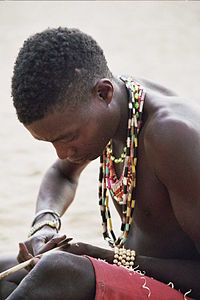Portal:Tanzania
 The Tanzania Portal
Tanzania, officially the United Republic of Tanzania, is a country in East Africa within the African Great Lakes region. It is bordered by Uganda to the northwest; Kenya to the northeast; the Indian Ocean to the east; Mozambique and Malawi to the south; Zambia to the southwest; and Rwanda, Burundi, and the Democratic Republic of the Congo to the west. Mount Kilimanjaro, Africa's highest mountain, is in northeastern Tanzania. According to the 2022 national census, Tanzania has a population of nearly 62 million, making it the most populous country located entirely south of the equator. Many important hominid fossils have been found in Tanzania, such as 6-million-year-old Pliocene hominid fossils. In the Stone and Bronze Age, prehistoric migrations into Tanzania included Southern Cushitic speakers who moved south from present-day Ethiopia; Eastern Cushitic people who moved into Tanzania from north of Lake Turkana about 2,000 and 4,000 years ago; and the Southern Nilotes, including the Datoog, who originated from the present-day South Sudan–Ethiopia border region between 2,900 and 2,400 years ago. These movements took place at about the same time as the settlement of the Mashariki Bantu from West Africa in the Lake Victoria and Lake Tanganyika areas. In the late 19th century, the mainland came under German rule as German East Africa, and this was followed by British rule after World War I when it was governed as Tanganyika, with the Zanzibar Archipelago remaining a separate colonial jurisdiction. Following their respective independence in 1961 and 1963, the two entities merged in 1964 to form the United Republic of Tanzania. Tanganyika joined the British Commonwealth and Tanzania remains a member of the Commonwealth as a unified republic. Tanzania is mountainous and densely forested in the north-east, where Mount Kilimanjaro, the highest mountain in Africa and the highest single free-standing mountain above sea level in the world, is located. Three of Africa's Great Lakes are partly within Tanzania. To the north and west lie Lake Victoria, Africa's largest lake, and Lake Tanganyika, the continent's deepest lake, known for its unique species of fish. To the south lies Lake Malawi. The eastern shore is hot and humid, with the Zanzibar Archipelago just offshore. The Menai Bay Conservation Area is Zanzibar's largest marine protected area. The Kalambo Falls, located on the Kalambo River at the Zambian border, is the second-highest uninterrupted waterfall in Africa. Tanzania is one of the most visited tourist destinations for safaris. Selected article -The Tanzania national football team (Swahili: Timu ya Taifa ya Mpira wa Miguu ya Tanzania) represents Tanzania in men's international football and is controlled by the Tanzania Football Federation, the governing body for football in Tanzania, Tanzania's home ground is Benjamin Mkapa National Stadium in Dar-es-Salaam and their head coach is Adel Amrouche from Algeria. They are colloquially known as the Taifa Stars. Tanzania has never qualified for the FIFA World Cup. Before uniting with Zanzibar, the team played as the Tanganyika national football team, The team represents both FIFA and Confederation of African Football (CAF). The island of Zanzibar, part of Tanzania (and once an independent nation), is also an associate member of CAF and has played matches with other nations, but is not eligible to enter the World Cup or Africa Cup of Nations. See Zanzibar national football team. (Full article...)General images -The following are images from various Tanzania-related articles on Wikipedia.
This month in Tanzanian history
Wildlife of Tanzania - Credit: yaaaay
The lion (Panthera leo) is one of the four big cats in the genus Panthera, and a member of the family Felidae. With some males exceeding 250 kg (550 lb) in weight, it is the second-largest living cat after the tiger. Wild lions currently exist in Sub-Saharan Africa and in Asia with a critically endangered remnant population in Gir Forest National Park in India. Did you know ...
CategoriesWikiProjectsRecognised contentSelected panorama -Skyline of the Dar es Salaam city center.
Uganda–Tanzania War -Articles here focus upon aspects of the Uganda–Tanzania War. These are all Good articles that meet a core set of high editorial standards.
The Battle of Masaka (Kiswahili: Mapigano ya Masaka) was a battle of the Uganda–Tanzania War that took place on 23 and 24 February 1979 in the town of Masaka, Uganda. Following artillery bombardment, most of the Ugandan government forces fled and Tanzanian and Ugandan rebel forces captured the town. Colonel Idi Amin had seized power in a military coup in Uganda in 1971 and established a brutal dictatorship. Seven years later he attempted to invade Tanzania to the south. Ugandan troops occupied the Kagera Salient and subsequently murdered local civilians and destroyed property. The attack was eventually repulsed, and Tanzanian President Julius Nyerere, unsatisfied with Amin's refusal to renounce his claims to Tanzanian territory and the international community's failure to strongly condemn the invasion, ordered his forces to advance into southern Uganda with the aim of capturing the towns of Masaka and Mbarara. (Full article...)TopicsSelected picture - Credit: Idobi
A Hadza man preparing arrow in Tanzania. The Hadza people live around Lake Eyasi and number less than 1000. 300–400 Hadza people still live as hunter-gatherers. ...Archive — Nominations
Related portalsThings you can doAssociated WikimediaThe following Wikimedia Foundation sister projects provide more on this subject:
Discover Wikipedia using portals | ||||







































































